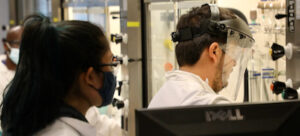Course materials for the Summer School for Silicon Nanotechnology, a Research Immersion in Materials Science & Engineering (RIMSE) program of the UC San Diego MRSEC, a National Science Foundation Materials Research Science and Engineering Center
The Summer School for Silicon Nanotechnolgy (SSSiN), run by Prof. Michael Sailor in the Silicon Nanomaterials Research Laboratory, is an immersive workshop focused on the synthesis, properties, and applications of silicon-based nanomaterials, with a focus on biomedical applications, chemical and biological sensors, quantum materials, and surface chemistry.
Lectures
Lectures are held every Monday, Wednesday, and Friday from 9-11 AM. Topics include: • Introduction to porous silicon—background and overview • Semiconductor fundamentals • Etching and electrochemistry of silicon • Photoluminescent Si “Quantum Dots” • Passive optical nanostructures—photonic crystals, optical diffraction, Fabry-Perot layers and multilayers • Characterization including porosity measurements, optics, FTIR, SEM, BET, Contact Angle • Freestanding porous silicon microparticles, nanoparticles, nanowires • Chemistry of silicon nanostructures • Biomaterials and medical applications of silicon nanostructures, including targeted drug delivery and in vivo systems • Metal and polymeric composites with porous silicon • Energy related materials including Li-ion anodes and thermoelectrics • Optical biosensing, chemical sensing. Lecture Notes are located on a shared Google Drive, which contains the lecture charts, experimental assignments, data files, software programs for working up data, Endnote(TM) reference files, published papers, PhD theses, internal forms, etc. Contact the lab manager for access.
 Hands-on Laboratory Training Sessions
Hands-on Laboratory Training Sessions
are held each weekday M-F, after the lectures. Researchers are trained in preparation and characterization methods and relevant to silicon nanomatierials: • electrochemical anodization to prepare porous silicon • stain etching • preparation of photonic crystals • surface chemical modification under anaerobic conditions • thermal processing • optical reflectance spectroscopy (RIFTS, SLIM) • photoluminescence spectroscopy • Raman spectroscopy • infrared spectrodcopy • porosimetry (surface area, pore size, porosity measurement) • scanning electron microscopy • contact angle measurement. You will be assigned to a 4-5-person Training Group that will be given instruction on the various instruments of use for materials characterization. The MRSEC facilities manages these instruments; a listing is given here. You will be trained on a subset of these.
 Discovery Project
Discovery Project
The “Discovery Project,” is an independent research project implemented by a team of 2-4 students under the mentorship of a current research group member. The research topics of the Discovery Projects harmonize with ongoing research projects in the Sailor Research Group. Many SSSiN students arrange to stay longer (up to 12 months) to complete a more extensive project, with the goal of initiating a longer-term collaboration, completing a thesis chapter, or producing a scientific publication. Many high school participants have translated their projects into California Science Fair, Lego Robotics Challenge, or Intel/Regeneron Science Talent Search competitions.
 Textbook
Textbook
The course follows the book “Porous Silicon in Practice” (Wiley, 2012). This book provides background on porous silicon nanostructures, their preparation, and their characterization. Each chapter contains descriptive experiments with step-by-step instructions to guide the trainee through the preparation of common porous silicon nanomaterial types. This is available as an e-book from the publisher (Wiley Online Library) through the UC San Diego Library.
 “Etching 101” video
“Etching 101” video
Before you go through your “Etch Test” you must review this YouTube video. Made by Gha Young Lee (SSSiN 2015), on the preparation of porous silicon by electrochemial anodization of crystalline silicon wafers in aqueous HF:ethanol electrolytes. It includes tips on cell design, mounting a wafer, leak-checking the cell, safety procedures, and personal protective equipment. The procedure is focused on the preparations given in the text “Porous Silicon in Practice: Preparation, Characterization, and Applications.” (Wiley-VCH: Weinheim, Germany, 2012).
 Lecture Notes and Other Documents
Lecture Notes and Other Documents
Google Drive containing the lecture charts, experimental assignments, data files, standard operating procedures (SOPs) for instruments, software programs for working up data, Endnote(TM) reference files, published papers, PhD theses, internal forms, etc. Contact the lab manager for access
![]() Safety Tour Document
Safety Tour Document
PDF file of the SailorGroup safety tour document, including the Safety Data Sheet for handling of hydrofluoric acid solutions.
![]() Porous Silicon Resources
Porous Silicon Resources
Link to our group page with online resources related to porous silicon and nanostructured silicon.
